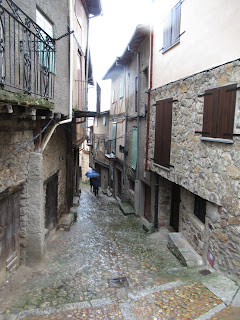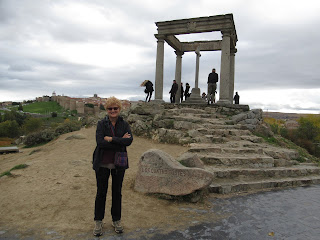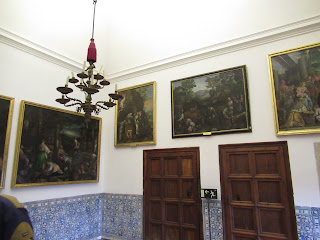As we drove south toward the medieval villages in Sierra de Francia, about an hour's drive south from Salamanca, we had a beautiful rainbow to start the day. We weren't sure but thought it was likely the first one since seeing a double rainbow at Machu Picchu last year!
It was pretty seeing the stacked rock walls just like the ones we’ve loved seeing over the years in Kentucky. How many centuries old were they, I wondered.
Never had we seen such a profusion of colored ferns like this before. I wondered if they thrived so well because of all the rain the area gets!
In the distance was the Basilica de San Vicente on the left.
The stunning altar in the Basilica featured San Lorenzo or St. Lawrence meeting his famous death. The Christian Spaniard reportedly told his pagan Roman executioners, "You can turn me over now - I'm done on this side!"
The Main Staircase was the main thoroughfare in the Convent's main part. Our eyes were immediately drawn to the gorgeous paintings and frescoes on its walls and ceilings.
The Guards' Room served as a vestibule to Philip II's Private Palace, a place where people coming and going could wait. It was also known as the chair room as it contained a chair traditionally associated with Philip II.
The back of the painting showed the restoration the painting received in 2011.
We had a bad case of sticker shock when filling up our rental with gas; the price was about $5.50 a gallon although that was ‘cheap’ compared to the $6.50 we’d spent in France earlier in the trip. I had a newfound understanding why the gilets jaunes or 'yellow vests' protesters were so concerned with the price of gas in the French countryside.
We passed trees like this for mile upon mile. but had no idea what they were.
The Sierra de Francia was one of Spain’s most rewarding collection of villages. Until recently secluded for centuries, the mountainous region with wooded hillsides and pretty stone and timber villages was once one of Spain’s most godforsaken regions from what I read. One of the largest and most beautifully preserved of the Sierra de Francia’s villages was La Alberca. It was an historical huddle of narrow alleys flanked by ramshackle houses built of stone, wood beams and plaster.
Steven decided to stay in the car but I couldn't resist walking up and down some of the streets even though it was drizzling. It was impossible not to think we'd come across a place time had forgotten about. If the weather had been more pleasant, it would have been fabulous to wander longer and spend more time in the shops.
Even if the weather was pretty stinking, the drive through the mountains was pretty fascinating at least from this passenger's point of view!
East of La Alberca was Mogarraz with some of the most evocative old houses in the region. It was also famous for its embutidos or cured meats. It was too rainy to stop so we drove onto Miranda del Castanar.
Thinking we'd never be back in the area, we found a parking spot and traipsed through the charming town trying to ignore the wet weather.
Then it was onto tiny San Martin del Castanar, described as the most enchanting with "half-timbered stone houses, flowers cascading from balconies, a bubbling stream and a small village bullring at the top of the town."
Perhaps because of the dreary weather, we found each of the towns in the Sierra de Francia to be very similar with narrow cobblestone streets flanked by high old stone and timber buildings, almost all with balconies. The weather and the fact it was a Sunday morning may have explained why the streets were almost totally empty of people.
According to Google Maps, this was Plaza Toros.
If we had even more time in Spain, I could certainly have seen spending a full day driving to each and then wandering around the small villages as they seemed utterly charming and picturesque. The weather, though, was almost the worst imaginable for doing any wandering as it was pouring cats and dogs.
Since leaving Salamanca that morning, we'd been heading toward Segovia, northwest of Spain's capital of Madrid, but decided to stop for a couple of hours in Avila, a town famous for its perfectly preserved medieval walls.
Surprise, surprise, about thirty miles south of Avila, we spied our second rainbow of the day! That was a record for us.
Coming across our first sight of the walls in the distance was so exciting. For more than 300 years, Avila was on the battlefront between the Muslims and Christians, changing hands several times.
Avila's fortified wall, built around 1100 on even more ancient remains, was the oldest, most complete and best preserved in Spain.
We had a marvelous view of the walled town of Avila about a mile away from the Cuatro Postes or Four Posts.
In the distance was the Basilica de San Vicente on the left.
Also on the left was the Cathedral. The sign said the battlements and sentry walks in the cathedral-castle combined harmoniously with the structure of the first Gothic temples in Spain.
Driving alongside the massive walls gave us even a better sense of their magnitude. With the wall's four gates and three entrances, visitors could walk around almost three-quarters of the wall.
We’d hoped to do that but ended up driving around the wall a couple of times looking in vain for a parking spot. I was able to snag some decent photos of the city’s churches from the car because we could only go at a snail’s pace because of all the traffic also hoping to find a parking spot.
If you've had a chance to go to Avila or will do so later, please make sure to let me know what you thought of the town so I can live vicariously! Luckily though, we’d had a spectacular view of the wall and the city earlier.
Since we weren't able to stop in Avila, we headed next toward the Monasterio de San Lorenzo de El Escorial, a 16th century palace built at a time when Catholic Spain felt threatened by Protestant 'heretics.' I was sure glad Steven was driving through the mountains as the fog was so bad.
As travel writer Rick Steves wrote, "The giant, gloomy building made of gray-black stone looks more like a prison than a palace. About 650' long and 500' wide, it has 2,600 windows, 1,200 doors, more than 100 miles of passages!" In the later 16th century, the extremely Catholic King Philip II ruled his empire from here, including giving directions to the Inquisition.
To 16th century followers of Martin Luther, it was the epitome of the evil of closed-minded Catholicism. The building was conceived of as a grand mausoleum for Spain's royal family, as a monastery to pray for the royal souls, a 'small' palace to use for Spain's royalty and finally as a school to embrace humanism in a way that promoted the Catholic faith.
Apart from the glorious altar, the artistic highlight of the basilica was the Carrara marble sculpture by Benvenuto Cellini of The Last Crucifixion. Jesus' features were supposedly modeled after the Shroud of Turin.
Because the Lower Main Cloister was the Main Cloister of the Convent, some of the most important paintings in the entire building were here. The main feast-day processions of the liturgical calendar were held in this cloister.
A series of bright, restored paintings in the cloister depicted the History of the Redemption by Pellegrino Tibaldi.
In rooms off the cloister were more striking paintings.
I adored the spectacular ceiling in the Room of the Vicar.
Other ceilings I was drawn to:
This painting looked like it opened in the middle; if it did, I wonder what surprise it would reveal.
Off the cloister was the Old or Borrowed Church which was used from 1571 to 1586 while finishing the basilica. From 1591 onward, burial services for the monks were held here. Above the altar was the powerful painting by Titian called the Martyrdom of St. Lawrence (i.e. San Lorenzo).
Following the success of a painting by El Greco for the Toledo cathedral in 1579 (more on this in a later post), Philip II commissioned the artist a year later to paint The Martyrdom of St. Maurice and the Theban Legion to decorate one of the side altar's in the Basilica of El Escorial. St. Maurice was selected because he was the patron saint of the Order of Fleece which was then headed by Philip II.
The maze gardens looked like they would be a lot of fun to explore but we didn't have time and the chilly weather at El Escorial's 3500' elevation would also have made us rethink traipsing through the gardens.
The Royal Pantheon was the final resting place of Spanish 26 kings and queens over four centuries. Philip II, who built El Escorial between 1563 and 1584, wanted to have a place to hold the remains of his parents, his own remains, and the remains of his descendants. He also wanted something built in remembrance of a battle victory against the French which occurred on August 10, 1557, the feast day of San Lorenzo. That is why the name of the monastery/palace complex contained the name 'San Lorenzo.' The crypt, located under the floor of the Basilica of El Escorial, has been the burial site for most of the Spanish kings of the last five centuries. One of those kings, King Charles I, was also the ruler of the entire Roman Empire.
It was heartbreaking to see the center of the Sixth Tomb Chamber that was taken up by a mausoleum, carved of white Carrara marble, that contained sixty niches on three levels for royal children who had died before the age of seven and their First Communion. The one in the middle was decorated with angels that bore the shields of the Royal Houses of Hapsburg and Bourbon.
Several rooms contained tombs of lesser royals. Each listed the person's name in Latin, the relationship to the king, and a slogan or epitaph.
It was interesting to learn that a certain post-mortem filing system was at work in the most important part of the Pantheon! The kings were on the left and queens on the right except for Queen Isabella II since she was the ruling queen and her husband was 'just' a consort. There was a waiting process to be ensconced in the Pantheon. Before a royal corpse can rest in the room, it needs to decompose for at least 25 years!
There were two chambers in the crypt called the pudridero, or better known as the Royal Rotting Rooms. Thankfully the 'Royal Rotting Rooms' weren't open to the public and could only be visited by monks from the Monastery. An interesting upcoming dilemma is that there were two sets of remains, numbers 24 and 25, the parents of retired King Juan Carlos I, in the pudridero awaiting final their remains, all tombs will be filled. No decision has yet been made as to the final resting place of King Juan Carlos and Queen Sofía, or for Felipe VI, the present king!
From the pantheon we walked through the living quarters. Philip II, the gout-ridden king of a dying empire, died in this room on September 13th, 1598, at the age of 71. The bed was in the same position so he could view the gardens and Mass at the basilica's high altar without ever leaving his bed!
It was from his small, plain and simple Study that the austere Philip II ran the Spanish Empire during its Golden Age in the 16th century when it extended to half of Europe and most of the Americas.The Study was furnished with a bookcase from the main Library which may have belonged to the king.
The clock/oil lamp used by Philip II was the work of a Flemish clock maker.
The Walking Gallery was where the royals got their exercise privately, with no risk of darkening their high-class skins with a tan, God forbid! The paintings depicted a series of royal palaces. The lovely tile work was a just a teaser of what we would later see in Portugal.
Across the room was a strip made out of slate called the Meridiana Solar, a sundial that showed the moment when the sun went through the local meridian at noon, solar time, by the projection of a shaft of light on the meridian itself. These solar adjusters were used to set clocks at the correct time, according to the position of the sun on the solar adjuster all year round.
The months were represented by the signs of the zodiac engraved on it and were illuminated approximately on the 21st of each month. As the instruments were installed during the reign of King Ferdinand VI, the letter 'F' surrounded the adjusters.
The paintings in the Hall of Battles celebrated Spain's great military battles including the Battle of San Quentin over France in 1557 on St. Lawrence's feast day which prompted the construction of El Escorial. The monumental series, painted in 1590, helped teach the new king all the elements of warfare.
I think this room had the most impressive series of paintings we’d ever seen. I could have spent hours in there paying close attention to the paintings which covered every inch of space. I wish my photos could give the hall justice but no photos were allowed so I had to take these on the sly as best I could.
If all the previous paintings weren't enough, there was also a separate Museum of Paintings of 15th to 17th century Flemish, Spanish and Italian works.
The museum's most famous work was by the Flemish painter Rogier van der Weyden. His Calvary showed the mourning Mary and St. John at the feet of the crucified Christ. This work was only one of three original van der Weyden works authenticated by archival works.
Although from outside El Escorial looked heavy and quite boring, the moment we entered was like entering a forbidden city. The UNESCO World Heritage site that was both a Monastery and a Royal Palace was a place of wonder.
Next post: Discovering Segovia and the Maltese Vera Cruz Church.
Posted on New Year's Day, 2019, from our home in Denver. May this new year bring each of you and your families much happiness and especially good health.


























































































Happy New Year to you both! Hopefully 2019 will bring even more exciting journeys that l can follow along with! I'm pretty sure l would love the museum of paintings and the Calvary one especially is so intense.
ReplyDeleteKemkem,
ReplyDeleteSorry for my late reply to your nice comments. Happy New Year to you and Federico and wishing you fun travels and adventures. I can't wait to read your posts reminding us there is so much still to explore. Steven and I would have loved to visit Valencia, your neck of the woods in Spain, but we ran out of time in that marvelous country.
2019 will be full of trips for us from beginning to end, but the trips will each be shorter for us, topping out at about six weeks each rather than the much longer single trip of about four months. Planning them already has been like juggling balls in the air and hoping none fall!
Annie